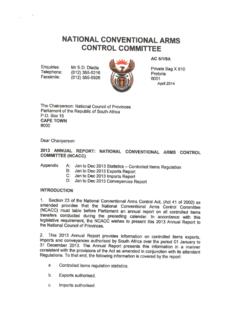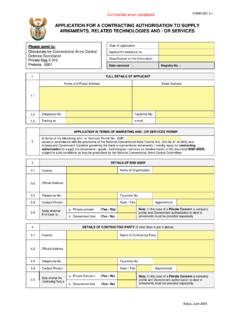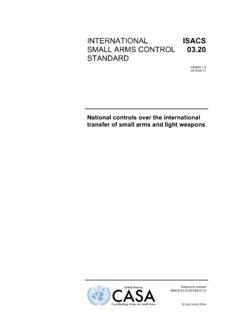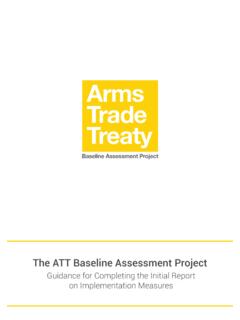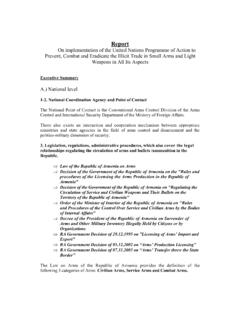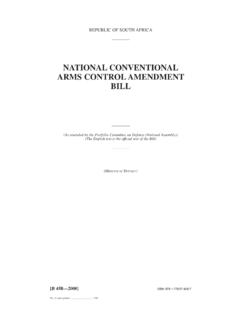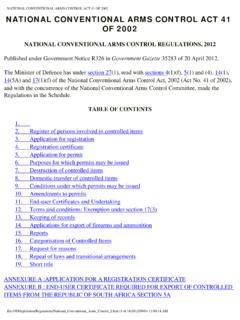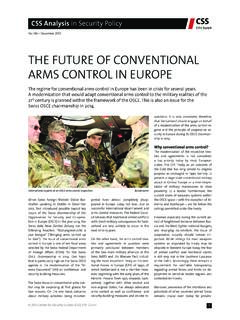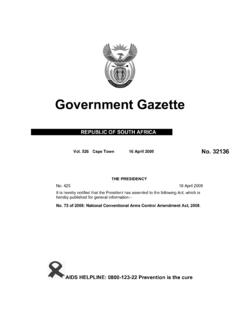Transcription of National Security Program D TI
1 AD-A247 422 National Security Program D TI CFLCTRESHAPING conventional CAPABILITIES:OPERATION "DESERT STORM" ANDTHE NEW WORLD ORDERHARVARD UNIVERSITYJohn F. Kennedy Schooi of Governmentr r: fcr pu' 32cbiserjbution ~A~i~4&afor -r i. ?..j~ f at ur ---D .t -RESHAPING conventional CAPABILITIES:OPERATION "DESERT STORM" ANDTHE NEW WORLD ORDERILTC(P) William G. Foster, USALTC(P) Daniel H. Layton, USALTC(P) Stephen H. Strom, USALTC(P) Robert M. Young, USAN ational Security Program Discussion Paper Series91-08i92-064851 92 3 II 015I IThe views expressed in this paper are those of the authors and do 3not necessarily reflect the official views of the United StatesGovernment, the Department of Defense, the United States Army, orHarvard !
2 UII0 1991 LTC(P) William G. Foster iLTC(P) Daniel H. LaytonLTC(P) Stephen H. StromLTC(P) Robert M. YoungIITable of ContentsList of Figures .. iiiExecutive Summary ..ivChapter 1. The Utility of conventional Military Force.. 1 The Strategic Role of conventional Forces .. 3 The Relationship of Strategy to Force Structure ..5 Outline of this Study..8 Chapter 2. Force Employment During the Era of Containment..15 Key Issues..16 Assumptions Regarding the Era of Containment ..18 Regional Confrontation in the Middle East ..22 American Policy 24 The Carter Doctrine and the Creation of the RDJTF 25 The Reagan Corollary and US Central Command ..26 Chapter 3. Reshaping conventional Force Capabilities:Building a Foundation from Crisis and Change.
3 31 National Strategy: Ends, Means, and Ways..32 The Ends-Means Relationship: ImperialOverstretch or Global Leadership..38 Military Roles: Deterrence and Warfighting..43 The Changed Global Environment..51 The Spectrum of Conflict ..54 The Challenge of Service Visions..56 The Navy Vision..58 The Army Vision..60 The Air Force Vision ..63 The Future Direction of conventional Force..65 Chapter 4. Achieving Political Ends by Military Means:Desert Shield to Desert Storm ..75 Operation DESERT SHIELD -- Intervention,Objectives and Deterrence ..77 Diplomatic Brinksmanship and theDevelopment of a "Desert Sword" ..80 Intervention Strategy: Overwhelming Force..83 Operation DESERT STORM -- Combat Operations ..86 Strategic Mobility.
4 91 The Airlift Program ..92 The Sealift Operation..93 Prepositioned Materiel ..95 Command and control -- The Force,Its Organization and Structure..96iii!The Reserve Component ..9 Maintenance and Theater ..102 Summary ..104 Chapter 5. Future Directions..109 Posturing for Future .. 111 iDeterrent Capability .. 115 Intelligence Focus..116 conventional arms control .. 117 Power Projection Capability.. 119 Sealift .. 120 Prepositioning.. 121A irlift .. 122 Coalition Warfare ..124 Active/Reserve Component Mix..127 Synchronization of Combat Powerand Service Visions.. 130 Some Concluding Thoughts ..131 Works Cited ..135 List of Figures 1 Figure Page 31-1 A Framework: The National Security Policy Process..10I3-1 National Strategy: Ends, Ways, and Means.
5 333-2 Military Posture ..52 33-3 The "Spectrum of Conflict" in the Cold War Era ..553-4 The "Spectrum of Conflict" in the Future ..56 53-5 Navy View of Conflict Spectrum ..603-6 Army View of Conflict Spectrum ..625-1 Factors Affecting conventional Military Force Posture..111 IIiv 1 IUNCLASSIFIEDSECURITY CLASSIFICATION OF THIS PAGEForm ApprovedREPORT DOCUMENTATION PAGE OMB No. 0704-0188la. REPORT Security CLASSIFICATION lb. RESTRICTIVE MARKINGSUNCLASSIFIED2a. Security CLASSIFICATION AUTHORITY 3 DISTRIBUTION /AVAILABILITY OF REPORTA pproved for public release; distribution is2b. DECLASSIFICATION / DOWNGRADING SCHEDULE !unlimited4. PERFORMING ORGANIZATION REPORT NUMBER(S) 5. MONITORING ORGANIZATION REPORT NUMBER(S)6a.
6 NAME OF PERFORMING ORGANIZATION 6b. OFFICE SYMBOL 7a. NAME OF MONITORING ORGANIZATION(If applicable) Army War College AWCA6c. ADDRESS (City, State, and ZIP Code) 7b. ADDRESS (City, State, and ZIP Code)Carlisle Barracks, PA 17013-5002Ba. NAME OF FUNDING/SPONSORING 8b. OFFICE SYMBOL 9. PROCUREMENT INSTRUMENT IDENTIFICATION NUMBERORGANIZATION (If applicable)8c. ADDRESS (City, State, and ZIP Code) 10. SOURCE OF FUNDING NUMBERSPROGRAM PROJECT TASK WORK UNITELEMENT NO. NO. NO. ACCESSION TITLE (Include Security Classification)Reshaping conventional Capabilities: Operation "Desert Storm" and the New World Order12. PERSONAL AUTHOR(S) Young, RobeFoster, William G., LTC(P); Layton, Daniel H., LTC(P): Strom, Stephen LTC(P): LTC(P)13a.
7 TYPE OF REPORT 13b. TIME COVERED .114. DATE OF REPORT (Year, Month, Day) 15. PAGE COUNTS tudy Project I FROM TOI 91 -08 14916. SUPPLEMENTARY NOTATION17 COSATI CODES 18. SUBJECT TERMS (Continue on reverse if necessary and identify by block number)FIELD GROUP SUB-GROUP19. ABSTRACT (Continue on reverse if necessary and identify by block number)The United States, as the pre eminent National power in the world today, mustcontinue to develop strategies for the employment of military force. The continuedrelevance of military force in the support of National objectives should be moreapparent today than even a short time change will be difficult. Barriers to change must be identified andovercome. Maintaining individual service charters within a joint operational frameworkmust continue to progress.
8 However, some factors will not change. Superiority over thesea and air access routes continues (in the absence of nuclear war) to be vital to thebasic survival of the nation. Yet, global naval superiority, critical in crisismanagem2nt and in long term conflicts, is less relevant to the prosecution of mid-intensity arbied regional engagements. Coalitions in regions where we have interestswill continue as a fundamental tenet of our global involvement. We will continue to20. DISTRIBUT!ON/AVAILABILITY OF ABSTRACT 21 ABSTRACT Security CLASSIFICATION0 UNCLASSIFIED/UNLIMITED E)I SAME AS RPT 0 DTIC USERS UNCLASSIFIED22a. NAME OF RESPONSIBLE INDIVIDUAL 22b TELEPHONE (Include Area Code) 22c. OFFICE SYMBOLROBERT C. WHITE, JR.
9 , COL, MI 717/245-30441 AWCAD Form 1473, JUN 86 Previous editions are obsolete Security CLASSIFICATION OF THIS PAGEUNCLASSIFIEDBLOCK 19 ABSTRACT (CONTINUED)plan to fight beyond our borders, working with allies abroad to control crises. Onceengagements begin, the ability to influence events on the ground through conventionalcapabilities remains the decisive element of combat. Our ability to project powerthrough a balance of complementary air, sea and land capabilities remains the key toeffective employment of conventional military SUMARYThe United States, as the pre-eminent National power in theworld today, must continue to develop strategies for the employmentof military force. The continued relevance of military force inthe support of National objectives should be more apparent todaythan even a short time ago.
10 In this regard, our principalassumptions regarding this force are the following:+ conventional deterrence will increase in Despite resource constraints, we must reshape conventionalcapabilities to address the growing diffusion of Increased flexibility in conventional force posture is neededto meet the spectrum of challenges we are likely to on these assumptions, we conclude that, in a resource-constrained environment, there are specific implications for futureconventional military force posture:* Deterrence, increasingly provided by conventional force, mustbe more relevant to regionally specific Balanced power projection capability through increasedstrategic mobility for lethal, sustainable, self-sufficientactive forces is Intelligence capabilities need a more global, less East-West,view with the ability to focus assets on regional hot * conventional arms control must be thoroughly integrated into Inational strategy to reduce potential conflict risk.










